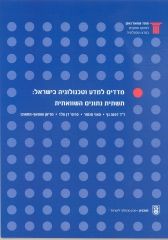It is well recognized that human capital, especially in the areas of science and technology, (S&T), is the main growth-enabling resource in Israel. How can this recognition be evaluated in light of the economic and statistical data over time? In this new Neaman Institute study we propose a systematic set of indicators, which can and should be monitored over time, to help assess Israel’s standing and investments in science, technology, and research and development (R&D), and to provide a basis for setting national policies influencing these activities.
We follow established procedures that have been adopted by OECD countries to monitor S&T activities: investments, human resources availability and training, and various output measures of R&D and scientific activities. We modify these indicators where needed to fit the different data series available in Israel and in a reference group of foreign developed countries. The countries resemble some key aspect of the Israeli economy or S&T environment, (e.g., population, GDP per capita, scientific standing, entrepreneurial support), and have available comparable S&T data. The sources used in this report include the Israeli Central Bureau of Statistics, similar statistical institutes in Europe and the US, other data sources, and the researchers own calculations.
The study notes, for instance, that national expenditures on civilian R&D in Israel rose 164% to NIS 23.8 billion in 1990-2004. The R&D expenditure share of GDP rose from 2.8% to 4.6% in Israel during the period 1996-2004, compared to a much smaller and hardly growing R&D expenditure share of GDP in the US, EU-15, Ireland or Finland, (the core reference group of countries in this study). However, much of this phenomenal growth in the share of resources directed to R&D in Israel comes from the business sector, which also performs nearly 75% of civilian R&D. This, and other measures provided in our report suggest a significant decline in the role played by the government in R&D and S&T activities, and in providing the infrastructure needed for their continued growth. Moreover, the data provided here on how the Israeli government support to industrial R&D is distributed across fields may raise concerns about the degree to which this support provides a pro-active market-failure-correcting base for continued high-tech success in the future.
Israel’s civilian workforce exhibits a higher concentration of R&D-related employment than other countries do. For instance, 26.5 workers per 1000 employees in the Israeli business sector are involved with R&D, compared to only 19.2 in Finland, 11 in Germany, and 6.9 in Ireland, (in 2001). Out of all employees in the business sector, the share of R&D workers in Israel is around 1.73%, compared to 1.29% in Finland and 0.52% in Ireland. This relatively heavy concentration on R&D underlies the often debated question about the extent to which a country can base its economic future on R&D, rather than on production and sale of goods and services. This issue is also intertwined with the flow and composition of academic degree recipients in Israel, covered in chapter 3 of the report.
Israeli inventors are very productive and increasingly so over time. Relative to population size, Israel lags only behind the US and Japan in number of patent applications since 1999 to the USPTO, (US Patent Office), and that number has doubled compared to its 1995 value. A similar picture is obtained when the number of patent applications is measured relative to R&D expenditures. However, the success of such Israeli inventors’ applications is not as impressive, with only 57.9% approval rate, compared to 65.6% approval rate for applications from other developed countries during the period 1990-1999. Israeli inventors’ relative position is less dominant at the European Patent Office, (EPO). Although Israeli patent applications constitute slightly less than 1% of the total number of patent applications submitted to both the USPTO and the EPO, (in absolute terms), there is a definite decline in Israeli patent applications overseas since 2001.
Israel does very well in terms of scientific publications per capita, compared to the US and the EU. Relying on Prof. Czapski’s extensive bibliometric data, Israel’s share of the world scientific publications in all fields is 1.28%, far exceeding its relative population size or its expenditure on science and technology relative to the world’s. In mathematics and computer sciences the Israeli share is even higher, 2.74% and 2.2%, respectively. The quality of Israeli scientific research is attested by the high citation rate of Israeli scientific publications compared to the average citation rate, across almost all scientific disciplines.
These excerpts from the Israeli S&T Indicators report suggest the potential usefulness for assessment of priorities in policy setting. The report will be updated periodically in the future, and accompanied by in-depth analyses of special topics as they pertain to S&T and R&D promoting policies in Israel. While an English version is not yet available, the Hebrew version of this report is available below. The report contains the following chapters: (1) Introduction, (2) National expenditures on civilian R&D, (3) Human capital in S&T and (4) Patents and scientific publications.












